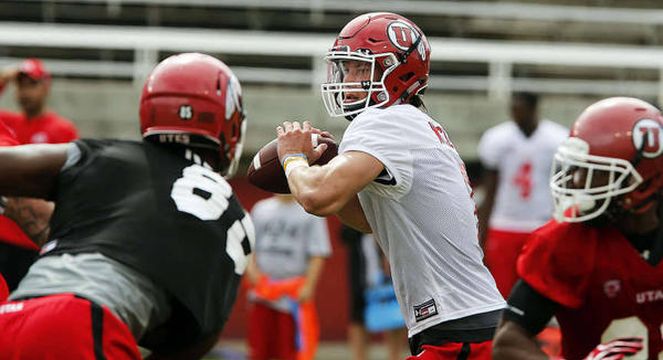Utes string fans and QB Travis Wilson along for another spring

The Utah football program appears to be back on the rise after a 9-4 season in 2014. The Utes finished the season ranked No. 21 in the nation after toppling Colorado State 45-10 in the Vegas Bowl but the team starts spring practices with some uncertainty thanks to the coaching staff.
Part of the resurgence for head coach Kyle Whittingham may have been part of the problem of suffering through back-to-back five win seasons in 2012 and 2013, and that was inconsistent play under center. That inconsistent play has been focused on senior to-be quarterback Travis Wilson.
The two-year starter threw for 1,827 yards with 16 touchdowns against 16 picks in a shortened 2013 season. The San Clemente, California native bounced back in 2014 to throw for 2,012 yards with 17 touchdowns while only throwing four interceptions in 12 games.
The sticking point, as it seems is the case every year in Salt Lake City, is trying to get better play in the passing game from the team’s quarterback. Wilson was injured at the end of the 2013 season, missed parts of spring ball in 2014 due to his injury, and had to deal with Whittingham declaring Oklahoma transfer Kendal Thompson the team’s starting quarterback before he ever stepped foot on campus.
At the end of it all, as one can easily guess will be the case again come fall, the 6’7”, 233 pound, quarterback was the main man on offense leading the Utes to their best season since 2010 and best record since joining the Pac-12 in 2014.
The perception is competition makes better of us all but might that idea be a misconception when dealing with Travis Wilson?
Utah has their stud running back Devontae Booker returning. The 5’11”, 212 pound, elite running back is the fuel that makes the Utes offense run. If Booker can reproduce the 1,350 yards of offense gained on the ground along with his nine touchdowns Utah will be back in the thick of the Pac-12 hunt again next season. Booker is also a relief valve for whoever gets the start under center. He had 39 receptions for 289 yards with another two touchdowns.
Whittingham knows where the team’s strengths lie, but he is hoping to push his quarterbacks to the next level opening up the competition to Kendal Thompson, Conner Manning, and Brandon Cox against Wilson.
Thompson, as do the other quarterbacks, deserves a fair shot at competing for the starting job. After all Thompson appeared in seven games last season getting the start against Oregon before leaving with a season ending knee injury. Due to his injury, Thompson is not cleared for contact drills during the spring but can throw with the offense to develop timing with the receivers. The big question is did Thompson finally have a good enough grasp of the offense by early November last year to become the quarterback Utah envisions for their future? Time will tell once Thompson is fully healthy this fall.
But in the meantime, does playing with Wilson’s confidence help him grow as player? If knowing he was the starting quarterback going into the 2015 season, would he accept that role and thrive? Or does he need to be pushed by constantly looking over his shoulder knowing he could be replaced at anytime? Not everyone thrives under that type of pressure. It happens far too often seeing a quarterback press trying to impress.
This is where coaching becomes critical to the growth of his players.
Co-offensive coordinator Aaron Roderick spoke about his senior quarterback stating, “’Each year he’s gotten a little better with decision-making, with reading the game. (We) would like to see him this year just keep progressing in that manner, be very efficient with the ball. That’s the key.”
Roderick added, “We don’t need (him) to throw for a million more yards, but we need (him) to be more efficient, a little more opportunistic and little bit more explosive.”
Wilson maybe limited in the pocket by not being a gunslinger like his Pac-12 counterparts but there is confusion in Roderick’s statement. Wilson completed 60.3 percent of his passes carrying a 4/1 touchdown to turnover ratio. How much more efficient can one collegiate quarterback be?
Among those that qualify USC quarterback Cody Kessler led the Pac-12 with a 69.7 percent completion percentage but then again the Trojans run a different offense than Utah’s I-formation pro-style attack. The Trojans also have a lot more talent on the outside than the Utes to help mask some possible deficiencies in the passing game.
Wilson was 11th in the Pac-12 in QB Rating posting a 134.7, far below Marcus Mariota’s Heisman Trophy winning season rating of 181.7. Kessler turned in a 167.1 followed by UCLA quarterback Brett Hundley’s 152.7, all potential NFL quarterbacks.
What the Utah coaching staff really wants is a 3,000 to 4,000 yard performer under center, an option they may not have on campus, or someone more akin to the other types of quarterbacks roaming the Pac-12.
Perhaps finally giving the two-year starter the reigns to the program without the embarrassment of having to fight for the honor day after day would be of far greater value to the team, the staff, and Wilson allowing everyone to gel in March and April instead of waiting until August and September? After all, is Booker’s starting job up for grabs?
Would this gesture turn Wilson into a Heisman Trophy candidate or a First-Team All-Pac-12 performer, of course not, but the stability and growth of the team along with that of their quarterback could be the long term difference meaning more wins on the field in 2015.
Written by Ryan Wright
Photo credit: desertnews.com; Travis Wilson drops back to pass during a Utah practice.
